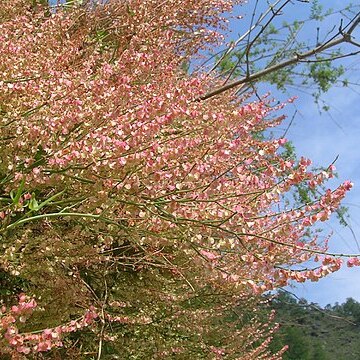Shrubs ?polygamous, 50-90 cm tall. Branches purple-brown, finely grooved; branchlets green, glabrous. Leaves solitary or fascicled; petiole 1.5-3.5 cm; leaf blade hastate, 1.5-3 cm × 1.5-2 mm, subleathery, central lobe linear or narrowly triangular, apex acute, basal lobes curved; ocrea fugacious, membranous. Inflorescence terminal, paniculate, lax. Pedicel slender, articulate below middle. Male flowers: tepals nearly uniform. Female flowers: outer tepals elliptic, reflexed in fruit; inner tepals enlarged in fruit; valves pinkish, orbicular or reniform, membranous, nearly pellucid, with small tubercle at base, base deeply cordate, margin nearly entire, apex obtuse or retuse. Achenes brown, shiny, ovoid, trigonous, ca. 2 mm. Fl. Apr-May, fr. May-Jun.
More
A herb. It has many branches. It grows about 1 m high. It has reddish brown stems. The leaves have stalks. They are 1.3-5 cm long and vary is size. They are flattened and spear head shaped with the leaf blade at right angles to the leaf stalk. They have a central lobe which in narrow and long and fleshy. The flowers are red. They occur in small clusters. The fruit is a nut. It is enclosed by the large ring of outer flower parts.

